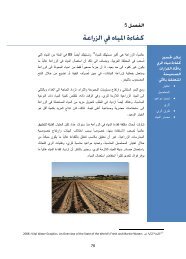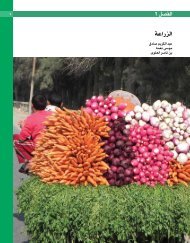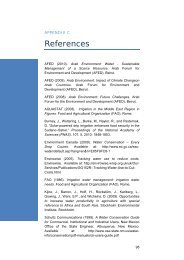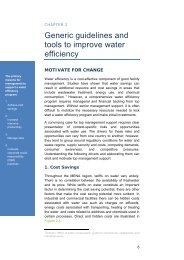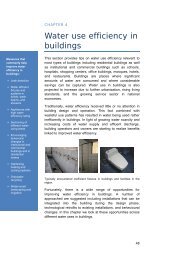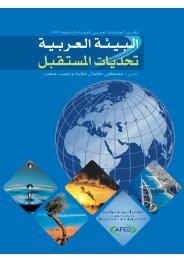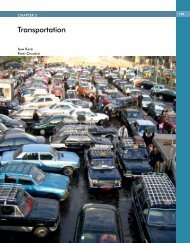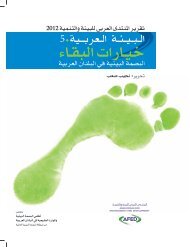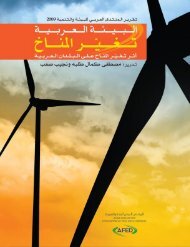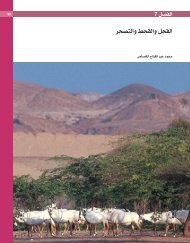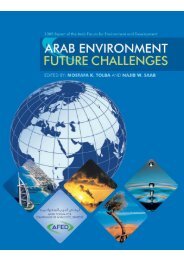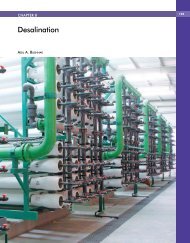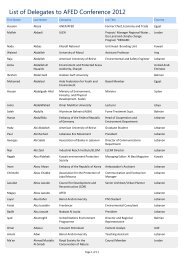Impact of Climate Change on Arab Countries - (IPCC) - Working ...
Impact of Climate Change on Arab Countries - (IPCC) - Working ...
Impact of Climate Change on Arab Countries - (IPCC) - Working ...
You also want an ePaper? Increase the reach of your titles
YUMPU automatically turns print PDFs into web optimized ePapers that Google loves.
104<br />
CHAPTER 8<br />
ECOSYSTEMS AND BIODIVERSITY<br />
TABLE 3<br />
THREATENED SPECIES IN EACH COUNTRY BY TAXONOMIC GROUP<br />
Country Mammals Birds Reptiles Amphibians Fishes Mollusks Other Animals Plants Total<br />
Invertebrates<br />
Algeria 14 11 7 3 23 0 14 72 3 75<br />
Djibouti 8 7 0 0 14 0 50 79 2 81<br />
Egypt 17 10 11 0 24 0 46 108 2 110<br />
Iraq 13 18 2 1 6 0 15 55 0 55<br />
Jordan 13 8 5 0 14 0 49 89 0 89<br />
Kuwait 6 8 2 0 10 0 13 39 0 39<br />
Leban<strong>on</strong> 10 6 6 0 15 0 3 40 0 40<br />
Libya 12 4 5 0 14 0 0 35 1 36<br />
Mauritania 14 8 3 0 23 0 1 49 0 49<br />
Morocco 18 10 10 2 31 0 9 80 2 82<br />
Oman 9 9 4 0 20 0 26 68 6 74<br />
Palestine 3 7 4 1 1 0 1 17 0 17<br />
Qatar 2 4 1 0 7 0 13 27 0 27<br />
Saudi <strong>Arab</strong>ia 9 14 2 0 16 0 53 94 3 97<br />
Somalia 14 12 3 0 26 1 50 106 17 123<br />
Sudan 14 13 3 0 13 0 45 88 17 105<br />
Syria 16 13 6 0 27 0 6 68 0 68<br />
Tunisia 14 8 4 1 20 0 7 54 0 54<br />
UAE 7 8 2 0 9 0 16 42 0 42<br />
Yemen 9 13 3 1 18 2 61 107 159 266<br />
Source: IUCN, 2008<br />
plants. Vavillov (1951) identified eight World<br />
Centers <str<strong>on</strong>g>of</str<strong>on</strong>g> Diversity <str<strong>on</strong>g>of</str<strong>on</strong>g> cultivated <str<strong>on</strong>g>of</str<strong>on</strong>g> which the<br />
Middle East is <strong>on</strong>e <str<strong>on</strong>g>of</str<strong>on</strong>g> the regi<strong>on</strong>s identified and<br />
it includes interior <str<strong>on</strong>g>of</str<strong>on</strong>g> Asia Minor, all <str<strong>on</strong>g>of</str<strong>on</strong>g><br />
Transcaucasia, Iran, and the highlands <str<strong>on</strong>g>of</str<strong>on</strong>g><br />
Turkmenistan. The total number <str<strong>on</strong>g>of</str<strong>on</strong>g> species in<br />
the Mediterranean regi<strong>on</strong> is 84 species which falls<br />
in third place am<strong>on</strong>g the other centres after the<br />
Chinese and the Indian Centers with their 137<br />
and 117 species, respectively (Perrino, 1988).<br />
The Mediterranean is the centre <str<strong>on</strong>g>of</str<strong>on</strong>g> origin <str<strong>on</strong>g>of</str<strong>on</strong>g> two<br />
fruit trees, the olive and carob tree, a large number<br />
<str<strong>on</strong>g>of</str<strong>on</strong>g> cultivated vegetables (30), spices (15),oil<br />
(6) and many <str<strong>on</strong>g>of</str<strong>on</strong>g> the old varieties <str<strong>on</strong>g>of</str<strong>on</strong>g> forage plants<br />
(11) (Perrino, 1988).<br />
To ensure the l<strong>on</strong>g range success in c<strong>on</strong>tinuing<br />
the evoluti<strong>on</strong> <str<strong>on</strong>g>of</str<strong>on</strong>g> genetic resources in the <strong>Arab</strong><br />
world in resp<strong>on</strong>se to climate change it is important<br />
to protect the diverse ‘ancestral’ genotypes in<br />
their country <str<strong>on</strong>g>of</str<strong>on</strong>g> origin from modern agricultural<br />
interference, in effect by ‘freezing’ the genetic<br />
landscape even to the extent <str<strong>on</strong>g>of</str<strong>on</strong>g> subsidizing ‘primitive’<br />
agro-pastoral systems (Vallianatos, 2006).<br />
The resp<strong>on</strong>ses <str<strong>on</strong>g>of</str<strong>on</strong>g> small communities to climate<br />
change by c<strong>on</strong>sistently c<strong>on</strong>structing their livelihoods<br />
in a generally sustainable approach sometimes<br />
deliberately c<strong>on</strong>serving or enhancing<br />
species and habitats should be seriously documented<br />
and strategically protected. Deliberate<br />
c<strong>on</strong>servati<strong>on</strong> <str<strong>on</strong>g>of</str<strong>on</strong>g> biodiversity by small communities<br />
is rarely evident for animal prey, particularly<br />
large game, whose very mobility <str<strong>on</strong>g>of</str<strong>on</strong>g>ten prevents<br />
local c<strong>on</strong>trol over access and hence diffuses any<br />
benefits from restraint. In c<strong>on</strong>trast most cases <str<strong>on</strong>g>of</str<strong>on</strong>g><br />
deliberate c<strong>on</strong>servati<strong>on</strong> apply to plant resources<br />
or habitats. Subsistence-based small-scale societies<br />
are likely to resp<strong>on</strong>d to climate change by<br />
pursuing enhancement <str<strong>on</strong>g>of</str<strong>on</strong>g> the resources needed<br />
for livelihood and allocating subsistence efforts to<br />
the most rewarding areas and resources currently<br />
available. These choices will <str<strong>on</strong>g>of</str<strong>on</strong>g>ten have the effect<br />
<str<strong>on</strong>g>of</str<strong>on</strong>g> c<strong>on</strong>serving habitats and biodiversity being<br />
impacted by climate change but they will not<br />
necessarily be designed to do so and may at times<br />
have the opposite c<strong>on</strong>sequence (Smith and<br />
Wishnie, 2000).<br />
III. SHIFTS IN SPECIES DISTRIBUTION<br />
RANGES IN RESPONSE<br />
TO CLIMATE CHANGE<br />
The <strong>Arab</strong> world harbours native species that tol-



